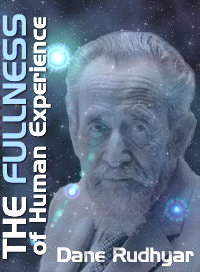 |
| Home | Bio | Art | Music | Literature | Civilization & Culture | Philosophy of Wholeness | Theosophy & Spirituality | Astrology |

CHAPTER THREE
The Cyclic Structure of the Movement of Wholeness - 2 The meaning of symmetry The circular diagram of the cycle of being printed here does not always refer to time as a measured factor. When the Hindu Puranas speak of periods of cosmic manifestation (manvantaras) and non-manifestation (pralayas) of Brahman as being equal in terms of years, the statement is relatively meaningless insofar as the pralayas are concerned. Time, as the objective factor to which human beings respond when they measure the speed of changes between markers of time indicating the beginning and end of a period, can have no experiential human meaning when there are no clocks, no moving celestial bodies, no atoms in the process of disintegration to serve as standards of measurement. If a specific length is given to pralaya, conceived as the "non-manifestation" of Brahman, it can only be because one assumes that the states of manifestation and non-manifestation in the whole cycle must be of equal duration. The cyclic pattern is assumed to be symmetrical. But the word symmetrical must be given a very broad meaning which suggests "correspondence" rather than what geometry calls symmetry. Symmetry should be understood in a qualitative rather than quantitative and measurable sense. The oscillations of a pendulum are measurably symmetrical, but the development of material and biological systems during one of the four quarters of the circular pattern (from Sunrise to Noon), and whatever is implied in the activity and consciousness of Pleromas in the opposite quarter from Sunset to Midnight, do not have to be symmetrical in terms of measured time. Yet the process of involution — from Midnight to Noon — develops in a manner that can be called symmetrical to that of the process of evolution from Noon to Midnight. Involution and, evolution are processes of opposite polarities, and in terms of the wholeness of the cycle they are complementary and symmetrical. The symmetry refers to the structural factor, but not necessarily to existential realities. One could evidently imagine and postulate that there is no essential structure, no definable order in the series of changes in the relation Unity-to-Multiplicity. Whatever happens and produces the impression of change in human organisms could be interpreted as a random sequence of alterations in the relationship of the experiencing organism to its total environment. Yet the periodic recurrence of many situations characterizing human existence assuredly implies the existence of at least a considerable degree of order. Moreover, the realization that our existence takes place within a field of ordered activities displaying definite (if not always easily definable) structural characteristics, seems essential to the full development of human consciousness. If there is random motion in the universe, this randomness may be attributed to the activity of the principle of Multiplicity; but while always present, it is nevertheless balanced in human situations by a factor of order. Indeed, the essential drive in the constitution, destiny, or dharma of humanity is the attempt constantly to increase the realization of that fundamental order and to give it a wider, more inclusive scope. Such an attempt is collective and takes the form of a culture. Each culture seeks to define this universal order in a specific way, and to establish a set of structural principles. In most cultures these principles are thought to be the dictates of a creative God; but the classical sciences, which for centuries have dominated the Western mind, speak of these principles of order as natural Law. The term law unfortunately evokes the existence of a law-giver; and science has no way to explain how these Laws of nature were imposed upon the release of cosmic energy in a postulated Big Bang. If we refuse to accept the reality of such a causal sequence of Creator and Creation, the bipolar cyclic pattern of the Movement of Wholeness may be considered the Law of Beness. Its structure is very simple and repetitive. As a basic structure it is invariant; yet we do not have to think of that structure as the only factor in the situations we are meeting as human beings. Invariance of structure does not have to negate variability in existential relationships, if we can also see at work a third factor able to re-establish structural order in the field of existence where it has been disturbed. This italicized "if" is crucially important, because if such a third factor were not operative we could rationally assume neither a permanent cosmic order (which would negate the possibility of human "free will"), nor the capacity of human persons to make individual choices (which might irreparably upset the fundamental order of the cosmos).(2) This third factor manifests in two basic ways: as Compassion (karuna in Buddhist terminology) and as karma. Compassion and karma operate in two basically different ways; the former consciously and deliberately, the latter unconsciously and compulsively. Through them, nevertheless, the essentially unpredictable variations and potential disturbances resulting from the unstructured and unrhythmic desires and activities of human individuals are reabsorbed into the invariant structure of the cycle. What was potential in the beginning (alpha) is fulfilled in the end (omega) of the cyclic Movement of being. The Wholeness of the whole remains undisturbed in its all-encompassing structural aspect. The disturbances are existential; and it is at this existential level that Compassion and karma operate as two modes of relatedness between parts of a whole. They are compensatory, restructuring types of operation through which Wholeness asserts its undismissible Presence through the momentary and surface modifications of the essentially and structurally unchangeable equilibrium inherent in cyclic motion. 2. The dilemma has, however, been given a non-rational and mysterious solution by theologians postulating the existence of a God who inexplicably creates cosmic laws which even he cannot break, while at the same time creating human beings free to alter them though it may mean eternal hell if they do — a hell which nevertheless would not restore the disturbed order! Return By permission of Leyla Rudhyar Hill Copyright © 1986 by Leyla Rudhyar Hill All Rights Reserved.  Web design and all data, text and graphics appearing on this site are protected by US and International Copyright and are not to be reproduced, distributed, circulated, offered for sale, or given away, in any form, by any means, electronic or conventional. See Notices for full copyright statement and conditions of use. Web design copyright © 2000-2004 by Michael R. Meyer. All Rights Reserved. |
 |
